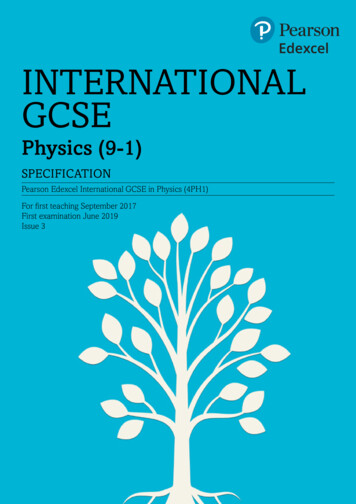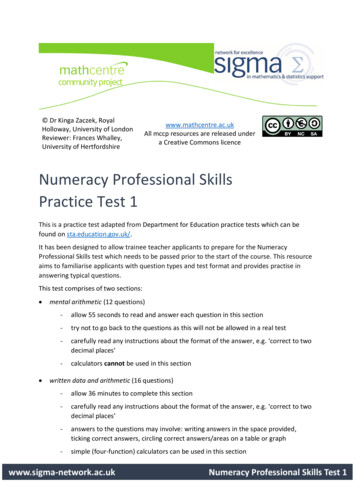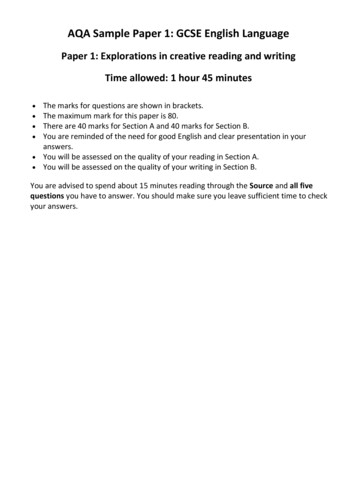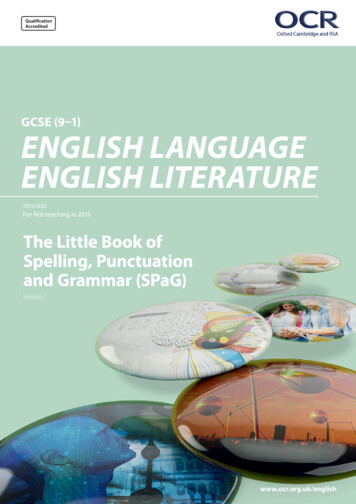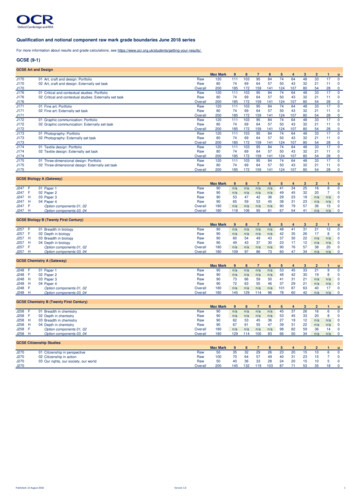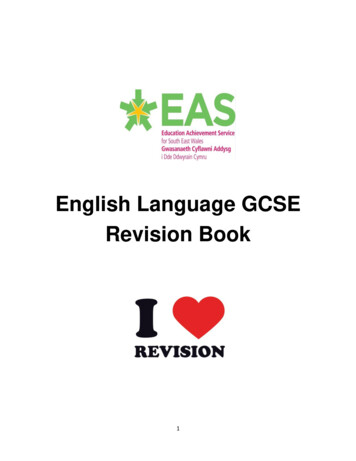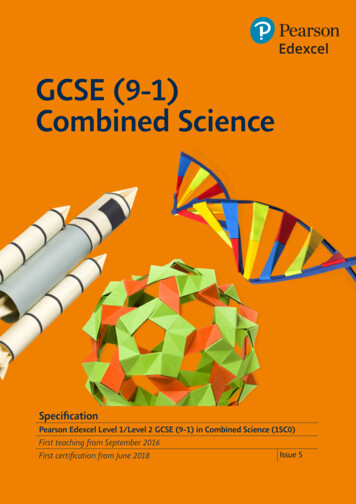
Transcription
GCSE (9-1)Combined ScienceSpecificationPearson Edexcel Level 1/Level 2 GCSE (9 - 1) in Combined Science (1SC0)First teaching from September 2016First certification from June 2018Issue 5
Summary of Pearson Level 1/Level 2 GCSE (9–1)in Combined Science (1SC0) specificationIssue 5 changesSummary of changes made between previous issue and this currentissue1.Replacement of spec point 1.43 on page 37 with 1.43Calculate:arelative formula mass given relative atomic massesbpercentage by mass of an element in a compound givenrelative atomic massesPage number37If you need further information on these changes or what they mean, contact us via ourwebsite at: tml
Contents1Introduction2Why choose Edexcel GCSE in Combined Science?2Supporting you in planning and implementing this qualification3Qualification at a glance427Subject contentBiology13Chemistry32Physics543Assessment information804Administration and general information83Entries83Access arrangements, reasonable adjustments, special consideration andmalpractice83Student recruitment and progression86Appendix 1: Mathematical skills89Appendix 2: Command word taxonomy91Appendix 3: Periodic table93Appendix 4: Equations in Combined Science94Appendix 5: SI Units in Combined Science97Appendix 6: Apparatus and techniques98Appendix 7: Practical Science Statement109Appendix 8: The context for the development of thisqualification110Appendix 9: Transferable skills112Appendix 10: Codes113Appendix 11: Calculators114
1 IntroductionWhy choose Edexcel GCSE in Combined Science?Supporting success in scienceScience matters. That’s why we’ve built the most inclusive GCSE (9–1) courses, so everystudent can enjoy science and succeed in their studies.Every student is different. With the same science and equal number of exams across ourtiered qualifications, you can structure the courses in the ways that mean you can bestsupport and stretch your students together.Our specifications are straightforward, and our selection of core practicals are designed tohelp bring science learning to life. And when it comes to our assessments, they’re shaped toencourage all students to best show what they know and can do.2Pearson Edexcel Level 1/Level 2 GCSE (9-1) in Combined ScienceSpecification – Issue 5 – September 2019 Pearson Education Limited 2019
Supporting you in planning and implementing thisqualificationPlanning Our Getting Started guide gives you an overview of the new GCSE qualifications to helpyou to get to grips with the changes to content and assessment and to help youunderstand what these changes mean for you and your students. We will give you editable schemes of work that you can adapt to suit your department. Our mapping documents highlight key differences between the new and 2011qualifications.Teaching and learningThere will be lots of free teaching and learning support to help you deliver the newqualifications, including: a free series of teacher, student and technician worksheets will help cover each element ofplanning and delivering every core practical a free practical guide to help you prepare for the changes to practical assessment a free maths guide for scientists to help you embed mathematics in your science teaching.Preparing for examsWe will also provide a range of resources to help you prepare your students for theassessments, including: additional assessment materials to support formative assessments and mock exams marked exemplars of student work with examiner commentaries.ResultsPlusResutsPlus provides the most detailed analysis available of your students’ examperformance. It can help you identify the topics and skills where further learning wouldbenefit your students.Get help and supportOur subject advisor service, led by Stephen Nugus and Julius Edwards will ensure youreceive help and guidance from us and that you can share ideas and information with otherteachers.Learn more at qualifications.pearson.comexamWizardexamWizard is a free exam preparation tool containing a bank of Edexcel GCSE Scienceexam questions, mark schemes and examiners’ reports. Existing questions will be reviewedand tagged to our new specifications so they can still be used, and question descriptions willbe updated.Pearson Edexcel Level 1/Level 2 GCSE (9-1) in Combined ScienceSpecification – Issue 5 – September 2019 Pearson Education Limited 20193
Qualification at a glanceContent and assessment overviewThe Pearson Edexcel Level 1/Level 2 GCSE (9–1) in Combined Science consists of sixexternally examined papers. These are available at foundation tier and higher tier.Students must complete all assessments in the same tier.Students must complete all assessment in May/June in any single year.Paper 1: Biology 1 (*Paper code: 1SC0/1BF, 1SC0/1BH)Written examination: 1 hour and 10 minutes16.67% of the qualification60 marksContent overviewTopic 1 – Key concepts in biology, Topic 2 – Cells and control, Topic 3 – Genetics, Topic 4– Natural selection and genetic modification, Topic 5 – Health, disease and thedevelopment of medicinesAssessment overviewA mixture of different question styles, including multiple-choice questions, short answerquestions, calculations and extended open-response questions.Calculators may be used in the examination. Information on the use of calculators duringthe examinations for this qualification can be found in Appendix 11: Calculators.Paper 2: Biology 2 (Paper code: 1SC0/2BF, 1SC0/2BH)Written examination: 1 hour and 10 minutes16.67% of the qualification60 marksContent overviewTopic 1 – Key concepts in biology, Topic 6 – Plant structures and their functions, Topic 7 –Animal coordination, control and homeostasis, Topic 8 – Exchange and transport inanimals, Topic 9 – Ecosystems and material cyclesAssessment overviewA mixture of different question styles, including multiple-choice questions, short answerquestions, calculations and extended open-response questions.Calculators may be used in the examination. Information on the use of calculators duringthe examinations for this qualification can be found in Appendix 11: Calculators.*See Appendix 10: Codes for a description of this code and all other codes relevant to thisqualification.4Pearson Edexcel Level 1/Level 2 GCSE (9-1) in Combined ScienceSpecification – Issue 5 – September 2019 Pearson Education Limited 2019
Paper 3: Chemistry 1 (Paper code: 1SC0/1CF, 1SC0/1CH)Written examination: 1 hour and 10 minutes16.67% of the qualification60 marksContent overviewTopic 1 – Key concepts in chemistry, Topic 2 – States of matter and mixtures, Topic 3 –Chemical changes, Topic 4 – Extracting metals and equilibriaAssessment overviewA mixture of different question styles, including multiple-choice questions, short answerquestions, calculations and extended open-response questions.Calculators may be used in the examination. Information on the use of calculators duringthe examinations for this qualification can be found in Appendix 11: Calculators.Paper 4: Chemistry 2 (Paper code: 1SC0/2CF, 1SC0/2CH)Written examination: 1 hour and 10 minutes16.67% of the qualification60 marksContent overviewTopic 1 – Key concepts in chemistry, Topic 6 – Groups in the periodic table, Topic 7 –Rates of reaction and energy changes, Topic 8 – Fuels and Earth scienceAssessment overviewA mixture of different question styles, including multiple-choice questions, short-answerquestions, calculations and extended open-response questions.Calculators may be used in the examination. Information on the use of calculators duringthe examinations for this qualification can be found in Appendix 11: Calculators.Pearson Edexcel Level 1/Level 2 GCSE (9-1) in Combined ScienceSpecification – Issue 5 – September 2019 Pearson Education Limited 20195
Paper 5: Physics 1 (Paper code: 1SC0/1PF, 1SC0/1PH)Written examination: 1 hour and 10 minutes16.67% of the qualification60 marksContent overviewTopic 1 – Key concepts of physics, Topic 2 – Motion and forces, Topic 3 – Conservation ofenergy, Topic 4 – Waves, Topic 5 – Light and the electromagnetic spectrum, Topic 6 –RadioactivityAssessment overviewA mixture of different question styles, including multiple-choice questions, short answerquestions, calculations and extended open-response questions.Calculators may be used in the examination. Information on the use of calculators duringthe examinations for this qualification can be found in Appendix 11: Calculators.Paper 6: Physics 2 (Paper code: 1SC0/2PF, 1SC0/2PH)Written examination: 1 hour 10 minutes16.67% of the qualification60 marksContent overviewTopic 1 – Key concepts of physics, Topic 8 – Energy - Forces doing work, Topic 9 – Forcesand their effects, Topic 10 – Electricity and circuits, Topic 12 – Magnetism and the motoreffect, Topic 13 – Electromagnetic induction, Topic 14 – Particle model, Topic 15 – Forcesand matterAssessment overviewA mixture of different question styles, including multiple-choice questions, short answerquestions, calculations and extended open-response questions.Calculators may be used in the examination. Information on the use of calculators duringthe examinations for this qualification can be found in Appendix 11: Calculators.6Pearson Edexcel Level 1/Level 2 GCSE (9-1) in Combined ScienceSpecification – Issue 5 – September 2019 Pearson Education Limited 2019
2 Subject contentQualification aims and objectivesGCSE study in the sciences provides the foundation for understanding the material world.Scientific understanding is changing our lives and is vital to the world’s future prosperity. Allstudents should learn essential aspects of the knowledge, methods, processes and uses ofscience. They should gain appreciation of how the complex and diverse phenomena of thenatural world can be described in terms of a small number of key ideas that relate to thesciences and that are both inter-linked and of universal application. These key ideas include: the use of conceptual models and theories to make sense of the observed diversity ofnatural phenomena the assumption that every effect has one or more cause that change is driven by differences between different objects and systems when theyinteract that many such interactions occur over a distance and over time without direct contact that science progresses through a cycle of hypothesis, practical experimentation,observation, theory development and review that quantitative analysis is a central element both of many theories and of scientificmethods of inquiry.These key ideas are relevant in different ways and with different emphases in the threesubjects as part of combined science. Examples of their relevance are given for each subjectin the separate sections below for Biology, Chemistry and Physics components of combinedscience.The GCSE in Combined Science should enable students to: develop scientific knowledge and conceptual understanding through the specific disciplinesof Biology, Chemistry and Physics develop understanding of the nature, processes and methods of science, through differenttypes of scientific enquiries that help them to answer scientific questions about the worldaround them develop and learn to apply observational, practical, modelling, enquiry andproblem-solving skills in the laboratory, in the field and in other learning environments develop their ability to evaluate claims based on science through critical analysis of themethodology, evidence and conclusions, both qualitatively and quantitatively.Students should study the sciences in ways that help them to develop curiosity about thenatural world, that give them an insight into how science works and that enable them toappreciate its relevance to their everyday lives. The scope and nature of the study should bebroad, coherent, practical and satisfying. It should encourage students to be inspired,motivated and challenged by the subject and its achievements.The key ideas specific to the Combined Science content include:BIOLOGY life processes depend on molecules whose structure is related to their function the fundamental units of living organisms are cells, which may be part of highly adaptedstructures including tissues, organs and organ systems, enabling living processes to beperformed effectivelyPearson Edexcel Level 1/Level 2 GCSE (9-1) in Combined ScienceSpecification – Issue 5 – September 2019 Pearson Education Limited 20197
living organisms may form populations of single species, communities of many speciesand ecosystems, interacting with each other, with the environment and with humans inmany different ways living organisms are interdependent and show adaptations to their environment life on Earth is dependent on photosynthesis in which green plants and algae trap lightfrom the Sun to fix carbon dioxide and combine it with hydrogen from water to makeorganic compounds and oxygen organic compounds are used as fuels in cellular respiration to allow the other chemicalreactions necessary for life the chemicals in ecosystems are continually cycling through the natural world the characteristics of a living organism are influenced by its genome and its interactionwith the environment evolution occurs by a process of natural selection and accounts both for biodiversity andhow organisms are all related to varying degrees.CHEMISTRY matter is composed of tiny particles called atoms and there are about 100 differentnaturally occurring types of atoms called elements elements show periodic relationships in their chemical and physical properties these periodic properties can be explained in terms of the atomic structure of theelements atoms bond by either transferring electrons from one atom to another or by sharingelectrons the shapes of molecules (groups of atoms bonded together) and the way giant structuresare arranged is of great importance in terms of the way they behave there are barriers to reaction so reactions occur at different rates chemical reactions take place in only three different ways:o proton transfero electron transfero electron sharing energy is conserved in chemical reactions so can therefore be neither created nordestroyed.PHYSICS the use of models, as in the particle model of matter or the wave models of light and ofsound the concept of cause and effect in explaining such links as those between force andacceleration, or between changes in atomic nuclei and radioactive emissions the phenomena of ‘action at a distance’ and the related concept of the field as the key toanalysing electrical, magnetic and gravitational effects that differences, for example between pressures or temperatures or electrical potentials,are the drivers of change that proportionality, for example between weight and mass of an object or between forceand extension in a spring, is an important aspect of many models in science that physical laws and models are expressed in mathematical form.All of these key ideas will be assessed as part of this qualification, through the subjectcontent.8Pearson Edexcel Level 1/Level 2 GCSE (9-1) in Combined ScienceSpecification – Issue 5 – September 2019 Pearson Education Limited 2019
Working scientificallyThe GCSE in Combined Science requires students to develop the skills, knowledge andunderstanding of working scientifically. Working scientifically will be assessed throughexamination and the completion of the eight core practicals.123Development of scientific thinkingaUnderstand how scientific methods and theories develop over time.bUse a variety of models, such as representational, spatial, descriptive,computational and mathematical, to solve problems, make predictions and todevelop scientific explanations and an understanding of familiar and unfamiliarfacts.cAppreciate the power and limitations of science, and consider any ethical issuesthat may arise.dExplain everyday and technological applications of science; evaluate associatedpersonal, social, economic and environmental implications; and make decisionsbased on the evaluation of evidence and arguments.eEvaluate risks both in practical science and the wider societal context, includingperception of risk in relation to data and consequences.fRecognise the importance of peer review of results and of communicating resultsto a range of audiences.Experimental skills and strategiesaUse scientific theories and explanations to develop hypotheses.bPlan experiments or devise procedures to make observations, produce orcharacterise a substance, test hypotheses, check data or explore phenomena.cApply a knowledge of a range of techniques, instruments, apparatus andmaterials to select those appropriate to the experiment.dCarry out experiments appropriately, having due regard to the correctmanipulation of apparatus, the accuracy of measurements and health and safetyconsiderations.eRecognise when to apply a knowledge of sampling techniques to ensure anysamples collected are representative.fMake and record observations and measurements using a range of apparatus andmethods.gEvaluate methods and suggest possible improvements and further investigations.Analysis and evaluationApply the cycle of collecting, presenting and analysing data, including:apresenting observations and other data using appropriate methodsbtranslating data from one form to anotherccarrying out and representing mathematical and statistical analysisPearson Edexcel Level 1/Level 2 GCSE (9-1) in Combined ScienceSpecification – Issue 5 – September 2019 Pearson Education Limited 20199
4drepresenting distributions of results and making estimations of uncertaintyeinterpreting observations and other data (presented in verbal, diagrammatic,graphical, symbolic or numerical form), including identifying patterns and trends,making inferences and drawing conclusionsfpresenting reasoned explanations including relating data to hypothesesgbeing objective, evaluating data in terms of accuracy, precision, repeatability andreproducibility and identifying potential sources of random and systematic errorhcommunicating the scientific rationale for investigations, methods used, findingsand reasoned conclusions through paper-based and electronic reports andpresentations using verbal, diagrammatic, graphical, numerical and symbolicforms.Scientific vocabulary, quantities, units, symbols and nomenclatureaUse scientific vocabulary, terminology and definitions.bRecognise the importance of scientific quantities and understand how they aredetermined.cUse SI units (e.g. kg, g, mg; km, m, mm; kJ, J) and IUPAC chemical nomenclatureunless inappropriate.dUse prefixes and powers of ten for orders of magnitude (e.g. tera, giga, mega,kilo, centi, milli, micro and nano).eInterconvert units.fUse an appropriate number of significant figures in calculation.Practical workThe content includes 18 mandatory core practicals, indicated as an entire specification pointin italics.Students must carry out all 18 of the mandatory core practicals listed below.BiologyCore practicals:1.6Investigate biological specimens using microscopes, including magnificationcalculations and labelled scientific drawings from observations1.10Investigate the effect of pH on enzyme activity1.16Investigate osmosis in potatoes6.5Investigate the effect of light intensity on the rate of photosynthesis8.11Investigate the rate of respiration in living organisms9.5Investigate the relationship between organisms and their environment usingfield-work techniques, including quadrats and belt transects10Pearson Edexcel Level 1/Level 2 GCSE (9-1) in Combined ScienceSpecification – Issue 5 – September 2019 Pearson Education Limited 2019
ChemistryCore practicals:2.11Investigate the composition of inks using simple distillation and paperchromatography3.6Investigate the change in pH on adding powdered calcium hydroxide/calcium oxideto a fixed volume of dilute hydrochloric acid3.17Investigate the preparation of pure, dry hydrated copper sulfate crystals startingfrom copper oxide including the use of a water bath3.31Investigate the electrolysis of copper sulfate solution with inert electrodes andcopper electrodes7.1Investigate the effects of changing the conditions of a reaction on the rates ofchemical reactions by:a measuring the production of a gas (in the reaction between hydrochloric acid andmarble chips)b observing a colour change (in the reaction between sodium thiosulfate andhydrochloric acid)PhysicsCore practicals:2.19Investigate the relationship between force, mass and acceleration by varying themasses added to trolleys4.17Investigate the suitability of equipment to measure the speed, frequency andwavelength of a wave in a solid and a fluid5.9Investigate refraction in rectangular glass blocks in terms of the interaction ofelectromagnetic waves with matter10.17Construct electrical circuits to:a investigate the relationship between potential difference, current and resistancefor a resistor and a filament lampb test series and parallel circuits using resistors and filament lamps14.3Investigate the densities of solid and liquids14.11Investigate the properties of water by determining the specific heat capacity ofwater and obtaining a temperature-time graph for melting ice15.6Investigate the extension and work done when applying forces to a springStudents will need to use their knowledge and understanding of these practical techniquesand procedures in the written assessments.Centres must confirm that each student has completed the 18 mandatory core practicals.Students need to record the work that they have undertaken for the 18 mandatory corepracticals. The practical record must include the knowledge, skills and understanding theyhave derived from the practical activities. Centres must complete and submit a PracticalScience Statement (see Appendix 7) to confirm that all students have completed the 18mandatory core practicals. This must be submitted to Pearson by 15th April in the year thatthe students will sit their examinations. Any failure by centres to provide this PracticalScience Statement will be treated as malpractice and/or maladministration.Pearson Edexcel Level 1/Level 2 GCSE (9-1) in Combined ScienceSpecification – Issue 5 – September 2019 Pearson Education Limited 201911
Scientific diagrams should be included, where appropriate, to show the set-up and to recordthe apparatus and procedures used in practical work.It is important to realise that these core practicals are the minimum number of practicalsthat should be taken during the course. Suggested additional practicals are given beneaththe content at the end of each topic. The 18 mandatory core practicals cover all aspects ofthe apparatus and techniques listed in Appendix 6: Apparatus and techniques. This appendixalso includes more detailed instructions for each core practical, which must be followed.Safety is an overriding requirement for all practical work. Centres are responsible forensuring appropriate safety procedures are followed whenever their students completepractical work.These core practicals may be reviewed and amended if changes are required to theapparatus and techniques listed by the Department for Education. Pearson may also reviewand amend the core practicals if necessary. Centres will be told as soon as possible aboutany changes to core practicals.Qualification contentThe following notation is used in the tables that show the content for this qualification: text in bold indicates content that is for higher tier only entire specification points in italics indicates a core practical.MathematicsMaths skills that can be assessed in relation to a specification point are referenced in themaths column, next to this specification point. Please see Appendix 1: Mathematical skills forfull details of each maths skill.After each topic of content in this specification, there are details relating to the ‘Use ofmathematics’ which contains the Combined Science specific mathematic skills that are foundwithin each topic of content in the document Combined Science GCSE subject content,published by the Department for Education (DfE) in June 2014. The reference in bracketsafter each statement refers to the mathematical skills from Appendix 1.EquationsThe required physics equations are listed in Appendix 4: Equations in Physics. The first listshows the equations which students are expected to recall for use in the exam papers. Theseequations may sometimes be given in the exam papers. The equations required for highertier only are shown in bold text. These equations are also listed in the specification content,in the physics section.12Pearson Edexcel Level 1/Level 2 GCSE (9-1) in Combined ScienceSpecification – Issue 5 – September 2019 Pearson Education Limited 2019
BiologyTopics common to Paper 1 and Paper 2Topic 1 – Key concepts in biologyStudents should:1.11.2Maths skillsExplain how the sub-cellular structures of eukaryotic andprokaryotic cells are related to their functions, including:aanimal cells – nucleus, cell membrane, mitochondria andribosomesbplant cells – nucleus, cell membrane, cell wall, chloroplasts,mitochondria, vacuole and ribosomescbacteria – chromosomal DNA, plasmid DNA, cell membrane,ribosomes and flagellaDescribe how specialised cells are adapted to their function,including:asperm cells – acrosome, haploid nucleus, mitochondria andtailbegg cells – nutrients in the cytoplasm, haploid nucleus andchanges in the cell membrane after fertilisationcciliated epithelial cells1.3Explain how changes in microscope technology, includingelectron microscopy, have enabled us to see cell structures andorganelles with more clarity and detail than in the past andincreased our understanding of the role of sub-cellularstructures1.4Demonstrate an understanding of number, size and scale,including the use of estimations and explain when they shouldbe used1d1.5Demonstrate an understanding of the relationship betweenquantitative units in relation to cells, including:1bamilli (10 3)bmicro (10 6)cnano (10 9)dpico (10 12)ecalculations with numbers written in standard form1.6Core Practical: Investigate biological specimens usingmicroscopes, including magnification calculations and labelledscientific drawings from observations1.7Explain the mechanism of enzyme action including the activesite and enzyme specificityPearson Edexcel Level 1/Level 2 GCSE (9-1) in Combined ScienceSpecification – Issue 5 – September 2019 Pearson Education Limited 20192h2a2h1d2a, 2h13
Students should:Maths skills1.8Explain how enzymes can be denatured due to changes in theshape of the active site1.9Explain the effects of temperature, substrate concentration andpH on enzyme activity4a, 4c1.10Core Practical: Investigate the effect of pH on enzyme activity2c, 2f1.11Demonstrate an understanding of rate calculations for enzymeactivity1.12Explain the importance of enzymes as biological catalysts in thesynthesis of carbohydrates, proteins and lipids and theirbreakdown into sugars, amino acids and fatty acids and glycerol1.15Explain how substances are transported into and out of cells,including by diffusion, osmosis and active transport1.16Core Practical: Investigate osmosis in potatoes2c, 2f4a, 4c1a, 1c1c2b, 2f4a, 4c1.17Calculate percentage gain and loss of mass in osmosis1a, 1c4a, 4cSpecification points 1.13 and 1.14 are in the GCSE in Biology only.Use of mathematics Demonstrate an understanding of number, size and scale and the quantitative relationshipbetween units (2a and 2h). Use estimations and explain when they should be used (1d). Carry out rate calculations for chemical reactions (1a and 1c). Calculate with numbers written in standard form (1b). Plot, draw and interpret appropriate graphs (4a, 4b, 4c and 4d). Translate information between numerical and graphical forms (4a). Construct and interpret frequency tables and diagrams, bar charts and histograms (2c). Use a scatter diagram to identify a correlation between two variables (2g). Understand and use simple compound measures such as the rate of a reaction(1a and 1c). Calculate the percentage gain and loss of mass (1c). Calculate arithmetic means (2b). Carry out rate calculations (1a and 1c).Suggested practicals Investigate the effect of different concentrations of digestive enzymes, using andevaluating models of the alimentary canal. Investigate the effect of temperatures and concentration on enzyme activity. Investigate plant and animal cells with a light microscope. Investigate the effect of concentration on rate of diffusion.14Pearson Edexcel Level 1/Level 2 GCSE (9-1) in Combined ScienceSpecification – Issue 5 – September 2019 Pearson Education Limited 2019
Topics for Paper 1Topic 2 – Cells and controlStudents should:2.1Describe mitosis as part of the cell cycle, including the stagesinterphase, prophase, metaphase, anaphase and telophase andcytokinesis2.2Describe the importance of mitosis in growth, repair andasexual reproduction2.3Describe the division of a cell by mitosis as the production oftwo daughter cells, each with identical sets of chromosomes inthe nucleus to the parent cell, and that this results in theformation of two genetically identical diploid body cells2.4Describe cancer as the result of changes in cells that lead touncontrolled cell division2.5Describe growth in organisms, including:acell division and differentiation in animalsbcell division, elongation and differentiation in plants2.6Explain the importance of cell differentiation in the developmentof specialised cells2.7Demonstrate an understanding of the use of percentiles chartsto monitor growth2.8Describe the function of embryonic stem cells, stem cells inanimals and meristems in plants2.9Discuss the potential benefits and risks associated with the useof stem cells in medicine2.13Explain the structure and function of sensory receptors, sensoryneurones, relay neurones in the CNS, motor neurones andsynapses in the transmission of electrical impulses, includingthe axon, dendron, myelin shea
a free practical guide to help you prepare for the changes to practical assessment . Electricity and circuits, Topic 12 – Magnetism and the motor effect, Topic 13 – Electromagnetic induction, Topic 14 – Particl
